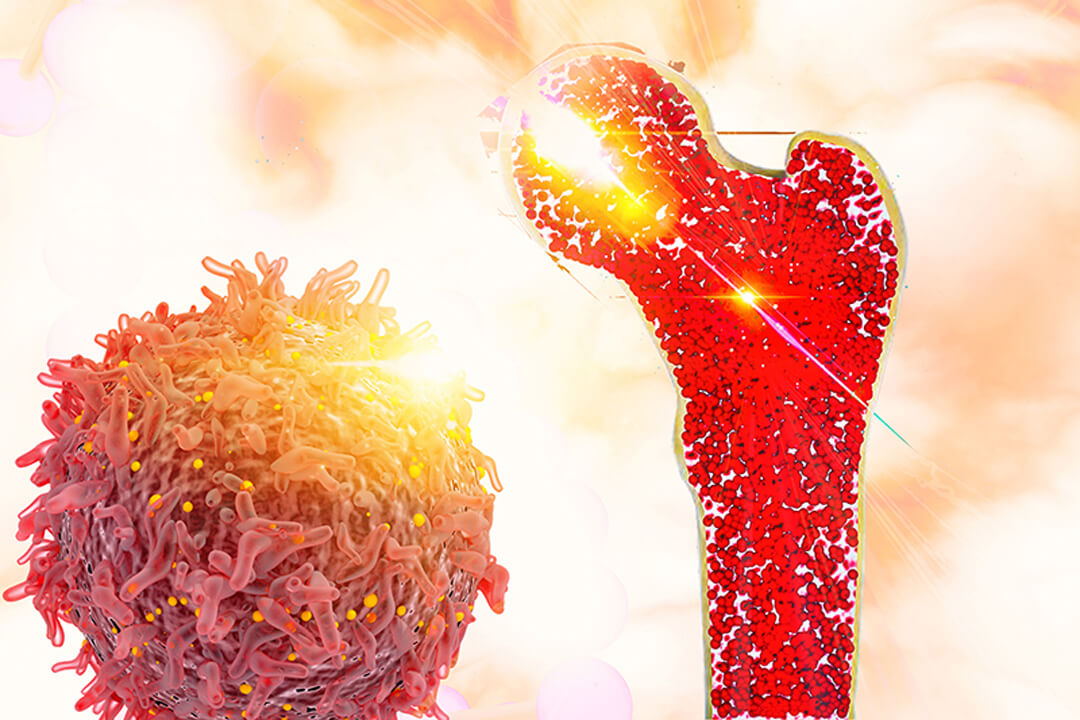

What is stem cell and bone marrow transplant?
Stem cell and bone marrow transplantation is the replacement of the patient’s bone marrow with a new bone marrow which is taken from a donor or the patient himself.
How can a person donate his bone marrow?
A person can donate his bone marrow under general anaesthesia, where special needles are used to collect the bone marrow from the pelvic bones, and this procedure takes around one hour, to collect 250-1000ml of a material which looks like blood.
The other way is to connect the donor to a machine like dialysis machine, which collect the stem cells only(which is a small percentage from the cells in the blood), and it returns the remaining cells to the donor, and these stem cells can be used similar to the use of bone marrow. The bone marrow transplant consultant will select the right method of collection according to the patient’s case.
What is autologous stem cell transplant?
When the stem cells are taken from the patient himself, this process called autologous transplant, or high dose chemotherapy and stem cell rescue, and it is done after the patient receive high dose of chemotherapy.
The collected stem cells from the patient will be frozen in liquid Nitrogen, till the patient receive the high dose of chemotherapy to get rid of the remaining cancer cells, then the stem cells are infused to rescue the bone marrow.
Autologous transplant is usually done for lymphomas, solid tumours like Ewing sarcoma, and neuroblastoma, where the main goal is to give high dose chemotherapy.
What is allogenic transplant?
It is a process where the bone marrow or stem cells are taken from a person other than the patient (a donor), then these sells are infused to the patient to replace his bone marrow.
The patient will receive chemotherapy to prepare his bone marrow to receive the donor’s cells. This transplant is usually done for leukemias, so the news cells will also attack any remaining leukemia cells. It is also done for bone marrow failure syndromes, and thalassemia.
How the bone marrow and stem cells are infused?
It is a simple procedure, similar to blood transfusion and takes less than one hour. Physicians and nurses deal with the procedure seriously to avoid any potential problem, or mistake.
The physicians and nurses inspect the stem cell unit to make sure it is the right one, and they observe the patient during the infusion.
The preservative material for the frozen stem cells produce a strong smell, which you might notice shortly after the beginning of the infusion, and it remains for 1-2 days, also you might notice the urine colour to be dark.
What are the risks of transplant?
You might have immediate complications, due to the chemotherapy, which include: mouth ulcers, nausea, vomiting, and a more serious complication which affects the liver and the severity of it depends on the degree of liver affection. The other complication is infections which might affect the blood stream, and it is usually treated with antibiotics till your count recover.
In the case of allogenic transplant there is a risk of rejection by your body to the stem cells.
What are the diseases treated by stem cell and bone marrow transplant?
A- Autologous transplant:
B- Allogenic transplant:
Phases of stem cell and bone marrow transplant:
1- First phase, Preparation:
The consultant physician will do tests on the patient to make sure that his organs are healthy and he has no infections, and will explain the process and its complications, and donor evaluation in case of allogenic transplant.
2-Second phase, giving chemotherapy and/or radiation:
This phase is done in the bone marrow transplant unit at the Specialty Hospital, and under the supervision of transplant consultant, clinical pharmacist, with experience in handling and preparation of chemotherapy, group of well-trained nurses to deal with transplant cases.
3- Third phase, infusion of stem cells and dealing with complications:
This phase is considered the most critical phase in transplant, because the patient’s immunity will be very low, and he will be at risk of infection, so he will be in a special room in the BMT unit under protective isolation, and these rooms are equipped with a filter to replace the air in the room frequently and get rid of any germs, for this purpose the Specialty Hospital invested in highly equipped room according to the international standards.
Also the patient during this phase will require blood and platelets transfusion.
4- Fourth phase, recovery of the bone marrow, and patient’s recovery from chemotherapy:
In this phase the immunity of the patient increases gradually, and the requirement for blood and platelets transfusion decrease till it stop, and the intravenous medications will be changed to oral.
5- Fifth phase, Follow up in the clinic:
The patient will need regular follow up in the clinic at least once/week to look for any complication and to follow blood tests.